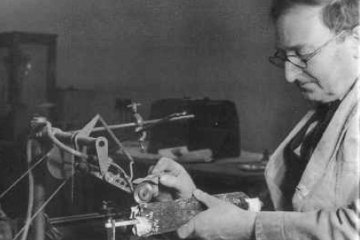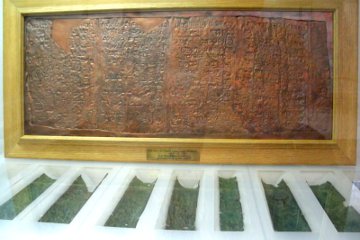Rolls of Copper
Here in Britain, where central heating is a necessity of life, older systems such as mine, which have put up with years of expansion as the system heats up and contraction when the temperature drops during the night, are often prone to leakage. The first tell-tale signs are a thin coating of green running along one of the copper pipes, showing that the copper is going "rusty" — oxidising, if you prefer the technical term. The only answer is to get out the wrenches and the plumbers' gum, drain the system, undo the failing joint and make the necessary repairs.

| |
| The Copper Scrolls as they were when first discovered. |
Would that things were so easy with the Copper Scrolls! Discovered along with the other Dead Sea Scrolls back in 1948, the Copper Scrolls were thin sheets of copper, 15" high and over eight feet long, on which more than 3,000 Hebrew characters were painstakingly embossed. The whole thing was then rolled up just like a scroll and stored with all the other scrolls in the desert near Qumran.
By the time of their discovery, however, the flexible copper had become hard and brittle and every attempt to unroll them simply resulted in breaking more bits off. Finally, in 1956 they were taken to the Manchester College of Science and Technology where Professor H. Wright Baker had developed an extremely thin circular saw blade. Using this saw he painstakingly cut along the sides of the scrolls, turning the rolled up metal into 23 half-cylindrical sections that could be carefully prised apart. Needless to say, the metal was so fragile that, despite Professor Baker's care, some of the priceless letters were lost in the process.

| |
| Professor H. Wright Baker carefully cut the scrolls into segments that could be prised apart. |
Unfortunately, the directions to the hiding places, although specific, are of very little use. One description reads: "In the tomb which is in the torrent of Ha-Kippa, on the way from Jericho to Sokokah, dig seven cubits: 32 talents". Given that a talent is approximately 70 lbs weight and assuming that we are talking either gold or silver here, it might be thought that this was a direction worth following. In fact, John Allegro, one of the first to translate the Copper Scrolls, actually talked the Jordanian government into sponsoring a search in the Qumran area and others have tried since. The problem is that the only intelligible words in the directions are "tomb" and "Jericho". No-one knows where the "torrent of Ha-Kippa" (which could also be Wadi Ha-Kippa) is and Sokokah is also an uncertain quantity. Even if you could find the right wadi and the right tomb, what is meant by "dig seven cubits" (approximately 10' 6")? Down? in the north wall of the tomb? or even just outside the tomb?

| |
| The segments of the Copper Scrolls in the Amman Museum today with the modern reconstruction behind them. |
Decipherment of the cryptic instructions is not helped by seven unusual abbreviations in the text, where single letters or letter-pairs appear. Fr Emile Peuch, who has just completed a new translation of the Copper Scrolls at the Ecole Biblique in Jerusalem, believes that these are code names for individuals who were responsible for the hiding places in seven different areas. The Copper Scroll, then, served as an aide memoire for these men and would be unintelligible to anyone without their specialised knowledge.
And finally, there is the possibility that all the treasure was retrieved in the end. The last entry on the scroll reads, "In the underground chamber which was built to the north of Kohlit, with its entrance to the north and the tombs at its opening, a duplicate of this document and its measurement and the inventory of everything, item by item." If this means what it seems to mean, there were duplicates of the Copper Scrolls, accurate right down to a measurement of the original, so that no one could cut off a couple of columns and keep the treasure for himself! It is entirely possible that the mysterious "K" and "Dl" lived long enough to make use of the duplicates and reclaim the hidden treasure.
Of course scholars have long puzzled over the origin of this vast quantity of treasure — some have even rejected the whole scroll as a fantasy. It seems unlikely that the poor Essenes of Qumran could have amassed so much gold and silver; some have, therefore, suggested that these were the treasures from the temple in Jerusalem, hidden to keep them safe from the advancing Romans. A brief reading of Josephus' description of events leading up to the siege of Jerusalem in AD 70 will dispel that idea. There were so many factions fighting inside the city, and they were all so greedy and corrupt, that it is highly unlikely that 26 tons of gold could have been transported out of the city without being noticed and stolen.
It is more likely that, in view of the Essene's well known honesty, people fearing the coming war, entrusted their treasures to them. It may even be that the Essenes were a form of bank used by commerce and business, which would explain why the country was divided into seven sections.
In the course of the Six Day War in 1967 the Israelis occupied the West Bank, capturing the Rockerfeller Museum where the Dead Sea Scrolls were kept. By a quirk of fate, however, the Copper Scroll was on the other side of the Jordan River, in Amman. It is the only one of the scrolls in Arab hands. The 23 precious sections have been kept in velvet lined cases, some of which are on display in the Amman Museum.
Unfortunately, once out of the super-dry cave beside the Dead Sea, the process of corrosion has proceeded apace, particularly attacking the vulnerable edges of the sections. In some cases as much as an inch has been lost from the edge, with the consequent disappearance of some of the irreplaceable information. In 1993 the Jordanian authorities sent the Scroll to France for much needed restoration work, paid for by the French state electricity company, Electricité de France. They were asked to restore and stabilise what remained, to reconstruct the text as far as possible, and to produce a modern copy of the Copper Scroll.
This has now been done and in March of this year the completed work was presented to Queen Noor of Jordan, who took it back to Amman. No doubt those on our tour next year will be able to see the completed restoration work and the new Copper Scroll in the Amman Museum.





